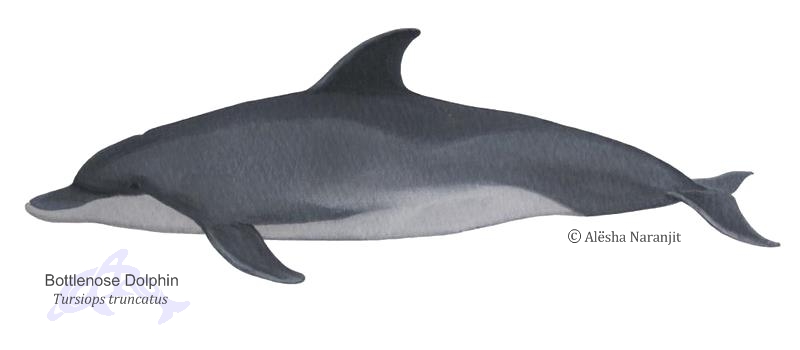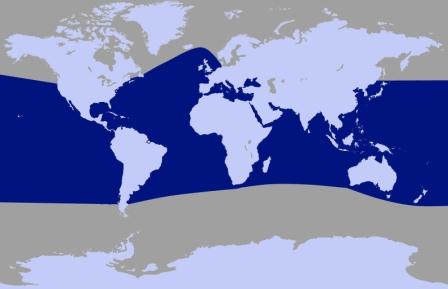
Classification Other Names: Gray Porpoise, Black Porpoise, Bottle-nosed Dolphin, Atlantic/ Pacific Bottlenose Dolphin, Cowfish Suborder: Odontoceti Family: Delphinidae | Description There are two forms: the offshore form is larger, robust and stockier, is darker in colour with smaller flippers; the inshore form is smaller and slimmer with longer flippers, a more slender beak and is paler in colour with a darker cape. More extensive body scaring is noticed in the offshore form and males of both forms. Usually females are slightly larger than males. Bottlenose Dolphins are notably inquisitive, active and very social. They can often be found in association with other cetaceans, sharks and sea turtles. Lone, wild, individuals (typically males) may seek out swimmers and small boats. Groups of individuals often provide mutual assistance to other groups and cooperate with local fishers. They are powerful swimmers which spend much time in highly active, playful aerobatics and can leap several meters out of the water. They typically wake and bow-ride with boats and larger whales.
|
Bottlenose Dolphin Ecology Range: Tropical and temperate waters between 45°N and 45°S at surface water temperatures between 10°C to 32°C. Usual Habitat: Can be found both offshore and inshore. Usual group size: Inshore groups vary from 1 - 10 and offshore groups are larger (1 - 25). Up to 1,000 individuals have been seen together. Main Diet: Fish, squid, srimp and other crustaceans. They use a wide variety of hunting techniques. Local population: Unknown | Global range of the Bottlenose Dolphin  The dark blue indicates where Bottlenose Dolphins are likely to be found |
Conservation Information
Protection and Conservation Status
IUCN Conservation Status: Bottlenose Dolphins are listed as "Least Concern" on the IUCN red list. SPAW Protocol: Bottlenose Dolphins are cetaceans, which are listed under Annex II of the SPAW protocol. As such they require total protection under article 11 of this protocol which prohibits the "taking, possession, killing and commercial trade of the species, their parts or products". The SPAW protocol was created to help with the implementation and promotion of the Ramsar Convention and the Convention on Biological Diversity. The Annexes of the SPAW protocol can be found here. Local Laws: Cetaceans are protected under the Conservation of Wildlife Act of Trinidad and Tobago which offers protection to all species not listed under the second or third schedules of this act. |
Reports of Bottlenose Dolphins in Trinidad and Tobago
This is currently being researched and written. It will appear here shortly.
|
References
The above information was obtained from the following sources:
- A Princeton Field Guide: Whales Dolphins and Other Marine Mammals of the World by Hadoram Shirihai and Brett Jarrett (2006)
- Smithsonian Handbooks: Whales Dolphins and Porpoises by Mark Carwardine and illustrated by Martin Camm (2002)
- The Whale and Dolphin Conservation Society's Species Guide at http://www2.wdcs.org/species/index.php
- The IUCN Redlist at http://www.iucnredlist.org
- The SPAW protocol Annexes with links available at http://www.car-spaw-rac.org/?Annexes-of-the-SPAW-Protocol,83
Acknowledgements
We would like to thank the following people for the use of the art work and photographs:
- Alësha Naranjit (Illustration of Bottlenose Dolphin)